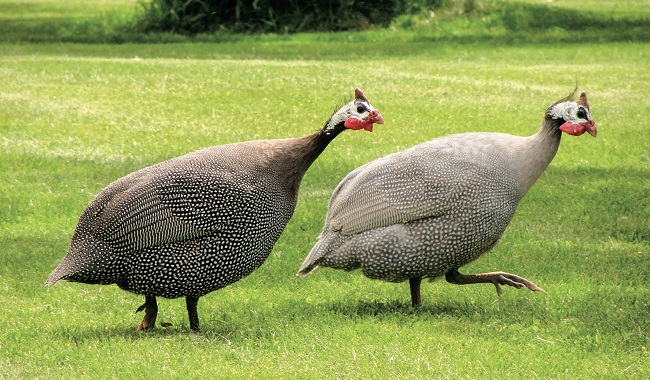Guinea fowls, native to Africa, have long been admired for their striking appearance and distinctive call.
Whether you are an aspiring poultry farmer, an avid bird-watcher, or someone who appreciates the diversity of avian species, understanding the different types of guinea fowl can enrich your experience and knowledge.
In this article, we delve into the fascinating world of Guinea Fowl Types, offering deep insights into their characteristics, habitats, and uses.

Popular Types of Guinea Fowl
There are several species of guinea fowl, but the following are among the most well-known and widely recognized:
Helmeted Guinea Fowl
The helmeted guinea fowl is the most common type and is notable for its largely grey or black body feathers covered in white spots. As the name suggests, it has a helmet-like casque on the top of its head, adding to its distinctive appearance.
Vulturine Guinea Fowl
The vulturine guinea fowl, recognized as the largest extant species, stands out with its vibrant blue and black plumage, elongated feathers, and bare skin around its head, much like a vulture. This species is commonly found in the dry savannas and scrublands of Eastern Africa.
Crested Guinea Fowl
The crested guinea fowl has an all-black appearance with a distinctive white crest. While less common in the poultry world, this species is cherished for its unusual aesthetic appeal.
Guinea Fowl: Uses and Benefits
Guinea fowl are not only kept for their beauty but also for various practical reasons:
Pest Control
Guinea fowl are known to consume large amounts of insects and can help control pests on a farm. They can be especially effective in managing tick populations.
Eggs and Meat Production
Guinea fowl produce eggs that are smaller than chicken eggs but are appreciated for their rich flavor. Their meat is also enjoyed as a delicacy in many parts of the world.
Watch Birds
Their loud and distinctive call makes guinea fowl excellent watch birds, alerting their keepers to any unusual occurrences within their environment.
Factors to Consider When Choosing a Guinea Fowl Type
Choosing the right type of guinea fowl involves considering several factors, including:
Purpose: Whether you aim for pest control, meat, or egg production, or simply as ornamental birds, the purpose will influence your choice of guinea fowl type.
Climate Adaptability: Different types of guinea fowl adapt to different climates. Ensure the type you choose can thrive in your local climate.
Space: Guinea fowl require sufficient space to roam and forage. Make sure you can provide adequate living conditions for the type you select.
Conclusion
Understanding the various types of guinea fowl is crucial to fully appreciate these unique birds’ diversity and charm.
Whether you are considering them for farming or simply expanding your avian knowledge, this information will help you make informed decisions about guinea fowl.
Remember, each type has its own unique characteristics, so take the time to choose the one that best fits your needs and environment.
























